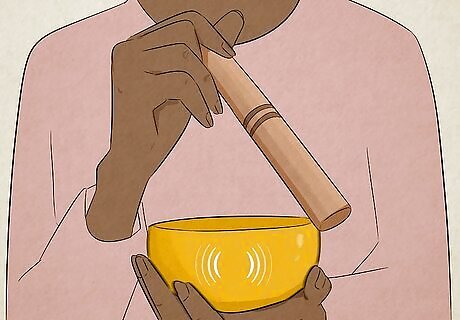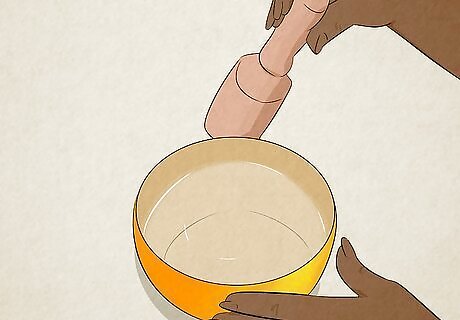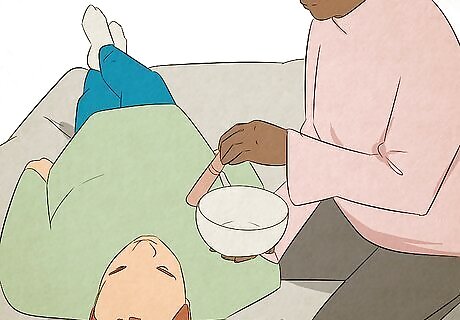
views
- Grip your mallet by the wooden end and gently strike the bowl on the outside at its widest point to produce a single rich, resonant note.
- Strike your bowl on the outside and then drag your mallet along the outer edge of the bowl’s rim with light pressure to produce a continuous “singing” sound.
- Singing bowls have a variety of supposed benefits including reducing pain, anxiety, and depression, aiding meditation and sleep, and balancing your chakras.
Striking the Bowl

Hold the bowl in your non-dominant palm or rest it on a cushion. If you choose to hold it, let it rest in your open palm or support it from the bottom with just your finger tips. Try not to grip the sides of the bowl with your finger, since this will dampen the sound. Alternatively, rest the bowl on a cushion. The cushion allows the bowl to vibrate without interacting with the hard surface underneath.

Grip the mallet or striker by the wooden end in your dominant hand. Hold the mallet between your pointer finger and thumb, almost like you’re about to use the mallet to sign your name. Make sure the very end of the mallet rests securely in the web between your pointer finger and thumb. Keep a firm and secure grip without squeezing or straining.

Strike the outside of the bowl at its widest point. Gently hit the bowl with the padded end of the mallet. Aim for where the bowl is the widest for the best sound (about midway up the bowl's wall). If the sound is dull or too quiet, hit it again slightly harder. Keep the mallet strikes away from the top of the lip of the bowl, since this will make a harsh, percussive sound. Alternatively, hit the bowl on the inside upper wall. Use larger mallets for large bowls and slimmer mallets for smaller bowls. Mallets can be padded with leather, felt, suede, or other materials. A padded mallet allows the lower, fundamental frequencies of the bowl to be heard more clearly (generally, higher tones carry more loudly than low ones).

Let the bowl ring or dampen the sound with your fingers. If you want to stop the sound before it naturally fades away, slowly alter your grip on the bowl (if you’re holding it) so that your fingertips come into contact with the sides of the bowl. If the bowl is resting on a cushion, softly touch the outside wall until the sound stops. Large bowls generally ring longer than small bowls.
Making the Bowl Sing

Find a quiet space and sit in a comfortable meditation pose. Seat yourself with your spine straight and relaxed and your shoulders level. Take several deep but natural breaths and try to release any tension in your arms, shoulders, and face. Singing bowls ring more clearly when you’re not holding any tension in your body.

Rest the bowl in your non-dominant palm or set it on a cushion. If you’re holding it, let it sit freely in your palm or on top of your fingertips without gripping the sides of the bowl (this will dampen the sound). Alternatively, sit the bowl on a small cushion or rubber ring. Try playing the bowl both ways and see which feels more comfortable for you. If your bowl is large or heavy, it may be easier to play it while it’s resting on a cushion. Smaller bowls are easier to hold in your hand.

Hold the wooden end of the mallet in your dominant hand. Grip it between your index finger and thumb as if you’re holding a pen (the same grip you’d use for a strike), or wrap all of your fingers around the end like you’re making a fist. Keep your grip firm but not too tense.

Strike the outside of the bowl first to get the sound going. It can be difficult to make the bowl sing just by rimming (dragging the mallet along the rim), so gently tap the mid-exterior wall of the bowl with the padded end of your mallet. Aim for the widest part of the bowl (about halfway up the wall), not too close to the lip. Let the sound ring for about a second before you begin dragging the mallet along the lip of the bowl.

Hold the mallet to the outside lip of the bowl at a 30- to 45-degree angle. Make sure the padded end of the mallet is in contact with the bowl, and apply light pressure as you prepare to drag it. The pressure ensures the mallet maintains contact with the bowl, producing an even and consistent sound. The best angle and pressure depends on your bowl and mallet combination. Play around with different angles until you find the sound that you enjoy the most.

Drag the padded end of the mallet around the outer rim of the bowl. Slowly circle the bowl until it’s ringing at the intensity you want. Use your whole arm to drag the mallet (not just your wrist). The sound will slowly build over the course of 4 or 5 times around the bowl. If you hear a rattling or grating sound, press the mallet more firmly against the bowl. In most cases, faster circles make a louder sound while slower circles produce a softer note. Machine-finished bowls will make a smoother, more consistent sound than hand-hammered ones because their lip is a perfect circle with no deviations.

Keep circling the bowl until you find a bright, clear overtone. Listen for a pure sound with no harsh edge to it (this will come more easily on machine-finished bowls). Once the overtone is ringing clearly, slow down the mallet slightly and apply a little more pressure to bring out the deeper, fundamental tones as well.

Try adding water to the bowl to experiment with different frequencies. To start, fill your bowl about halfway with clean water and try striking or rimming it again. Play around with different amounts of water to see what pitches and overtones you get—the possibilities are endless! Make sure no water gets on the outside of the bowl, since this can dampen the sound. Try not to overfill your bowl since it can spill out once you start playing and affect the quality of the bowl’s sound and vibrations. Adding water usually creates a deeper, longer-lasting tone than an empty bowl. It’s also mesmerizing to watch the water “dance” inside the bowl from the vibrations.
Benefits of Singing Bowls

Aiding meditation The sound of a singing bowl can ease you into a meditative state whether you’re brand new to meditating or you’ve been doing it for years. The act of deeply listening to the pitch of the bowl puts you in touch with your surroundings and all of the noises around you, helping to clear your mind.

Reducing physical pain or tension Studies have shown that singing bowl users feel less pain after meditating with one. Experimentees rated their pain on a point scale of 1 to 5 before meditating with a singing bowl. Afterwards, reports of pain were reduced by as much as 1.21 points in some age groups. Users who were brand new to singing bowls reported a bigger difference in their perceived pain levels.

Lowering feelings of anxiety and depression In the same study, singing bowl users also reported feeling less anxiety, depression, and tension after a meditation session, as well as increased feelings of spiritual well-being. These results were stronger in experiment participants who had never used a singing bowl before. This means that singing bowls can not only reduce negative feelings, but increase positive ones as well.

Aiding massages or sound baths Singing bowls of various pitches can be combined to create a sound bath or to target specific body parts during a sound massage. When the frequency of a bowl matches the frequency of a body part, like your stomach, legs, or chest, the massage or sound bath recipient can feel the bowl’s vibration in their body. Results are different for everyone since each person’s body is a different size and sensitivity. Sound massages usually last 30-75 minutes while full sound baths can last 60-90 minutes. The bowls may be placed on your body or played right next to you. Most people get a massage or sound bath on a weekly or monthly basis (repeated treatments are more effective than one-offs). Sound baths can incorporate a wide variety of instruments like gongs, chimes, and bells to create an immersive sound that fills the room and your body for relaxation.

Improving sleep quality The calming, resonant tones of singing bowls can relax your body and mind and facilitate easier, more restful sleep. The tones are said to synchronize the left and right hemispheres of the brain for relaxation as well as reduce physical tension.

Chakra healing Each of the body’s 7 chakras resonates at a specific frequency. When a singing bowl hits one of these frequencies, it balances and opens the corresponding chakra through sound and vibrations. Look for a set of chakra healing bowls pitched at the right frequencies for balancing. The frequencies for each chakra are: Root Chakra: 396 Hz Sacral Chakra: 417 Hz Solar Plexus Chakra: 528 Hz Heart Chakra: 639 Hz Throat Chakra: 741 Hz Third Eye Chakra: 852 Hz Crown Chakra: 963 Hz
Singing Bowl Traditions

The origin of singing bowls is controversial. Many Westerners believe singing bowls have been an important part of Tibetan and Himalayan rituals for hundreds of years, but the historical evidence to support that they have a special place in Eastern spirituality is inconclusive. Many academics and historians agree that singing bowls might have roots in the Himalayas, but that their prevalence has been exaggerated to Western tourists. Singing bowls have grown in popularity over the last 50 years in the West, possibly because of the 1972 album Tibetan Bells by Nancy Hennings and Henry Wolff.

Traditional singing bowls are usually made from a bronze alloy. The bronze may be mixed with copper, tin, zinc, iron, silver, gold, nickel, or a combination of several metals. Different combinations of metals produce different tones and pitches, most of which are very bright and deep. Other bowls are made from quartz crystal and produce different sounds. In some practices, different metals are related to different celestial bodies: Gold: the Sun Silver: the Moon Tin: Jupiter Lead: Saturn Copper: Venus Iron: Mars Mercury: Mercury



















Comments
0 comment